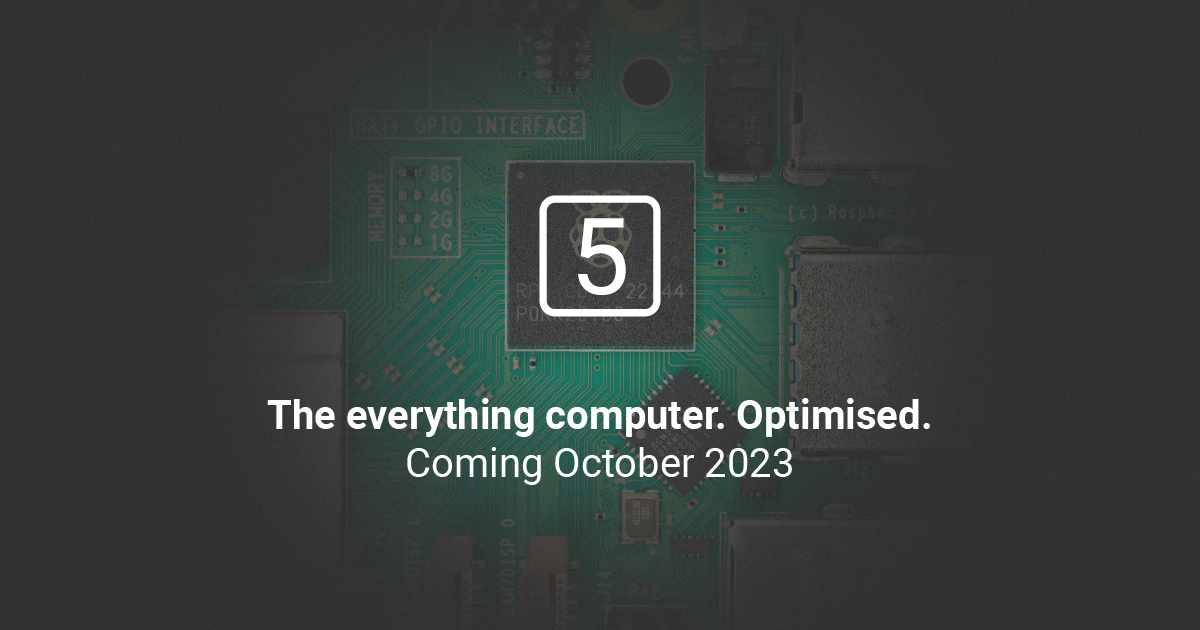- Broadcom BCM2712 2.4GHz quad-core 64-bit Arm Cortex-A76 CPU, with cryptography extensions, 512KB per-core L2 caches and a 2MB shared L3 cache
- VideoCore VII GPU, supporting OpenGL ES 3.1, Vulkan 1.2
- Dual 4Kp60 HDMI® display output with HDR support 4Kp60 HEVC decoder
- LPDDR4X-4267 SDRAM (4GB and 8GB SKUs available at launch)
- Dual-band 802.11ac Wi-Fi®
- Bluetooth 5.0 / Bluetooth Low Energy (BLE)
- microSD card slot, with support for high-speed SDR104 mode
- 2 × USB 3.0 ports, supporting simultaneous 5Gbps operation
- 2 × USB 2.0 ports
- Gigabit Ethernet, with PoE+ support (requires separate PoE+ HAT)
- 2 × 4-lane MIPI camera/display transceivers
- PCIe 2.0 x1 interface for fast peripherals (requires separate M.2 HAT or other adapter)
- 5V/5A DC power via USB-C, with Power Delivery support
- Raspberry Pi standard 40-pin header
- Real-time clock (RTC), powered from external battery
- Power button



I’ve got to wonder, am I the only one that wishes these things came with PoE support out of the box without needing an addon? I can’t even find a competitor that supports PoE without needing an extra PoE HAT.
Tbh, POE isn’t a feature most people need. And it’s quite expensive, takes up a lot of room, and generates quite a bit of heat.
You can get inline POE extractors that spit out 5v usb/jack or 12 jack. I use them quite a lot, and they are much cheaper than PoE hats
Yeah I just hate all the extra clutter the extractor adds. It’s really nice to just run some cat 6 to a Pi and call it a day. If I could spend an extra $50 to get a Pi or Pi-like device that came with PoE built in I would in a heartbeat.
I know what you mean.
The problem is, actual POE powered computers end up being commercial display drivers or embedded/industrial systems. And that means a significant increase in price.
These devices are often plugged into things that require power. At which point, you can just power it locally. So the added cost and complication of POE isn’t worth it.
Chances are, a lot of the things you are trying to do don’t need a full SBC and Linux. But I don’t know your situation.
Something like this: https://www.dfrobot.com/product-1286.html
Or this.
https://www.robotpark.com/Arduino-Ethernet-Microcontroller-With-PoE-Power-over-Ethernet-V3
If it’s something like a screen/touchscreen interface, theres already power there…
But you could use an android TV, there are some that are POE powered, but most displays have a power source these days.
Things like Bluetooth or whatever, you can probably get off-the-shelf extenders or repeaters.
I’d love it if it was more common, gives an easy way to remotely power cycle devices. But the ridiculous extra cost that PoE enabled general purpose devices come with just isn’t worth it for me.
Right now the main things I’m using it for is running PiHole and home-assistant, although there’s a few other network services I’d like to run on a couple Pi’s. So yeah, I can’t really use embedded devices for that. I could use something like a NUC, but that’s adding significant cost at that point, easily into the $200+ range, where I’m trying to keep it below $150. All my switches already provide PoE, and I need to run ethernet to the device anyway for network connectivity, so adding new PoE devices is literally just a single cable. If I’m powering them a more traditional way I’ve got to deal with a power brick and finding space in an already crowded UPS, or finding someplace to tack up a PoE extractor in a crowded shelf.
PoE runs on 48V, it’s nontrivial to get that down to levels usable by a microprocessor.
It’s not free, but it’s not really that hard either. You can even get fancy and use isolated power for some extra safety.
I’d like to see some more specialized versions of these boards. For instance one that trades the MIPI ports (which I have literally never found a use for) for PoE or some other feature that’s more useful in a networking centric use case. In many cases I’d even be willing to give up a USB port for that.
Yeah well, that’s like the whole area for the USB and Ethernet plugs taken up. You also definitely want an isolated one for a device that’s supposed to be used by end users.
It’s really not, you have a buck reg on board already, it’s just the peripherals that need 5v and for a lot of that you can use linear regs.
Yeah there’s a buck regulator on board, but the caps for it are far too tiny for 48V. The ones you need are much bigger.
Not… really. Remember the voltage rating increases but the capacitance itself can reduce so the dielectric just increases in size but shrinks in layers. Same energy, but since it’s cv^2 you can actually reduce capacitance more.
You’re talking about the bulk input tanks which need to be 100v, the rest of them past the inductor should be the same.
All thus being said, nobody will do this, not for a good reason, the guys who do power circuits think differently than the guys who do logic and their state space equations say it’s not safe, which would be true for reactive loads but for this kind of logic it’s mostly resistive with some obnoxious parasitic inductance and nasty switching noise that the supply caps would filter.
This is changing with the younger generation who don’t have those prejudices.
Olimex had a ARM board with POE, if I remember correctly… though I cannot find it atm. Here’s an ESP based instead: https://www.olimex.com/Products/IoT/ESP32/ESP32-POE/open-source-hardware